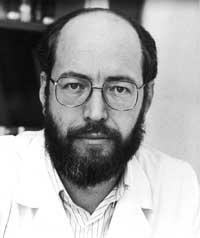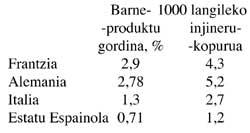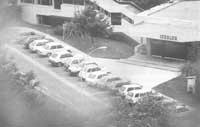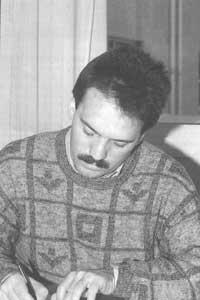Technological research
1994/01/01 Rodriguez Ibabe, Jose Maria Iturria: Elhuyar aldizkaria
The absence of scientific powers until recently has been very harmful to the Basque Country. One of the most important impacts has been the non-development of technological research. In addition, with some exceptions, the relatively small size of most workshops has made it virtually impossible to develop research in workshops. Therefore, most of the Basque industries reached the 1970s without developing technological research.
Despite not being an investigation, the technical managers of the industry sought other ways to make their products competitive. Now the situation is different. Technological research in other European States has been developing for a long time, and to cope with its products, research cannot be rejected here either.
There are seven research centres sponsored by the Basque Government (Ceit, Ikerlan, Inasmet, Tekniker, Gaiker, Labein and Robotiker). These centres represent the highest percentage of resources for technological research in the Basque Country.

In applied research, the client/supplier relationship must also be analyzed. The industry must develop a series of products obtaining an adequate quality/price ratio (to be competitive in the market). His scope is not research, but on more than one occasion he will need research to achieve his goals.
In order to make the offer suitable from the point of view of the technology center, different points of view must be taken into account. On the one hand, the center must be equipped with the right equipment and on the other hand, the level of researchers must be taken into account. In terms of instrumentation, throughout the 1980s the centres of the Basque Country were significantly improving, in most cases thanks to public money.
As for the level of technicians and researchers, the problem is much more complex. Given that the conditions of creation of each center are different and taking into account the differences between the different departments of each center, it is not possible to give a global view of this topic. However, the lack of research tradition in our country has not contributed at all.
The methodology needed for research does not suddenly emerge. Therefore, relations with foreign research centers in the creation of the research group have been very important and thanks to this, the research methodology developed for some time in other states is fully integrated here. However, the other working groups did not have that relationship and today their behavior is evident. In this sense, and recalling again the lack of tradition, in some cases it has been possible that technicians who have not carried out any research work throughout their life are now responsible for research centers. This is difficult to see in foreign centers.
Finally, communication must be taken into account in this industrial/research relationship. Many times the researcher does not understand what the industry wants. Similarly, on more than one occasion the researcher finds it difficult to find a suitable technical partner in the workshop. These difficulties can make the work done in the center unrelated to what the industry needs.
Therefore, when it is stressed that 1.6% of GDP in R&D (CAPV target for next year) is used in statistics, this number is theoretical. If only projects that have supported the industry were taken into account, the amount mentioned above would be at least half. That is, in my opinion, the main obstacle that must overcome technological research in the Basque Country in the coming years. Otherwise, if it does not affect the industrial network, this type of research makes no sense.

Gai honi buruzko eduki gehiago
Elhuyarrek garatutako teknologia





